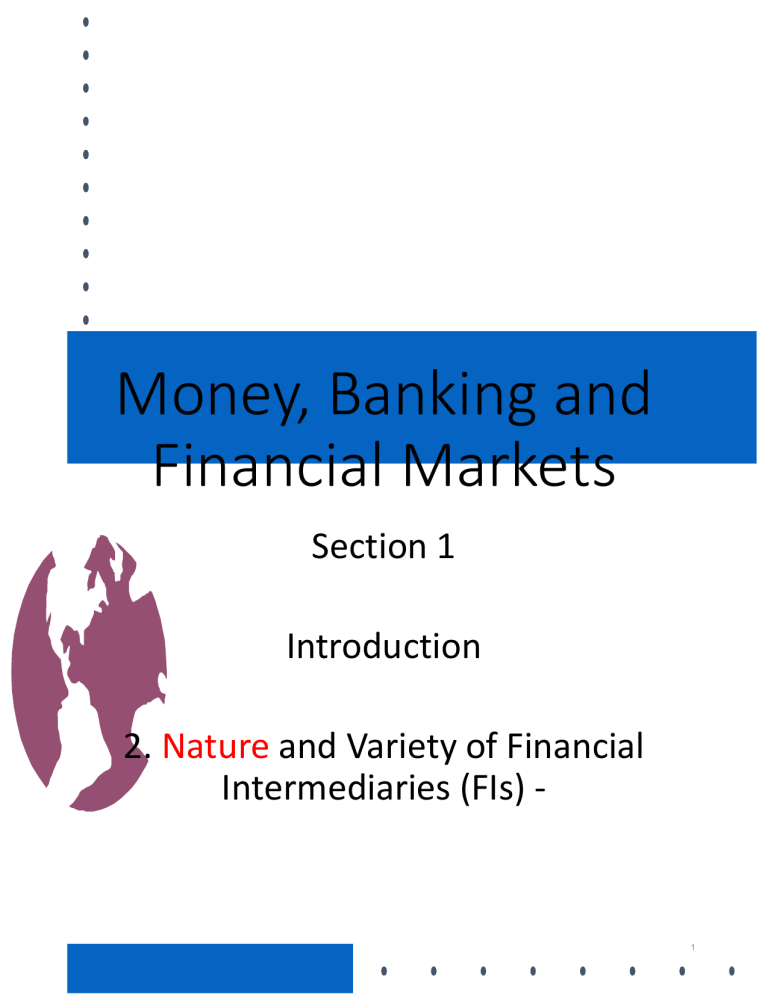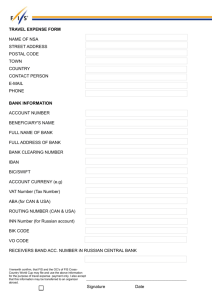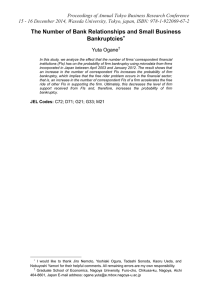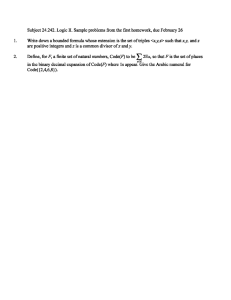
Money, Banking and Financial Markets Section 1 Introduction 2. Nature and Variety of Financial Intermediaries (FIs) - 1 Objectives 1 • Understand the motivation of this course. • Explain why Financial Intermediaries (FIs) exist ? •Explain how Adverse Selection can cause a market failure •Find how FIs can save on screening costs. 2 Introduction to the Course • Finance and Economics – focus difference. •Example : options -Finance -Economics 3 An exchange with two people • Person 1: •Person 2: •The exchange 4 Advantages of financial exchange 1. Completing Projects 2. Smoothing over Time 3. Smoothing over Space 5 FINANCIAL INTERMEDIARIES •DEFINITION: •FINANCIAL INTERMEDIARY (F.I) •Contemporary Financial Intermediation “WHY” IS MORE POWERFUL KNOWLEDGE Main FI: But still keep it general: 6 Why do FIs exist ? 1. Advantage in producing information “Brokerage” 2. Transforming Assets ”Qualitative Asset Transformation” Financial Intermediation Services Brokerage QAT 7 Information Contracts •Financial Contract •Key: •Asymmetric Information •Pre-contract information •Post contract information 8 Key Informational Problems Pre-contract Informational Asymmetry Adverse Selection Post-contract Informational Asymmetry Moral Hazard 9 Adverse Selection (AS) : “Hidden Information” •“Lemons” Story and Intuition •”Evaluation Costs” to overcome AS •Applying ”Lemons” to Credit Markets 10 Adverse Selection (AS) Example •Akerlof (1970), used car example. For now we will use the used car example return to finance later. •We will show that AS can lead to a market failure: •Example: I am willing to sell for $ 2000., a ”good car.” Buyer willing to pay $ 2500. If there was no problem, an exchange would occur, i.e. if the buyer could evaluate the proper value: 11 Adverse Selection (AS) Example •But suppose the buyer knows there are lemons out there worth $1000 and the buyer cannot differentiate between lemons and the $2500 car. Assume buyers know chance is 50/50 good car/lemons. “bad cars” = lemons •What will happen now ? •But then a market failure would exist ! 12 Adverse Selection & Market Failure (cont) •Now there will be a market failure because… 13 Adverse Selection with Screening •Suppose to overcome the adverse selection, buyers can overcome with an evaluation cost ? What are some examples of this in the used car market ? •In the previous example, if there were an evaluation cost option, what is the largest amount a borrower would pay for evaluation ? 14 Answers 1. 2. 15 Application of “lemons” market Apply to credit markets and explain how the market could fail in this case, e.g. instead of good and bad cars we have… (just in words) – meaning of adverse selection. Explain what evaluation costs are now ? 16 THIS COURSE Section 1: FIs and Financial System •Motivation of FIs •Varieties of FIs •Sources of Financing •Types of Risks Section 2: Lending and Credit Risk and Other Financial Instruments •Writing Loan Contracts •Different Types of Off-Balance Sheet Banking and Contingent Claims Products Section 3: Securitization and Deposits •Creating Securities •Deposits and Bank Runs SYLLABUS •Textbook -available directly as e-book from library -hardcover copies on Reserve • Three Exams (in class, on paper) • True False • Fill in the Blank • Matching • Multiple Choice •Problems •Exam 3 not cumulative, before Thanksgiving •Weighting • 30 % two highest exams, 20 % lowest exam • 20 % quizzess QUIZZES: 2 Types 1. Quizzes on Reading of that Day – 5 points – Not all days, random. On Canvas 2. Quizzes on Canvas – 10 points - Based on Homeworks mostly Extra Credit (points added to exams) 1.Random group work in class. 2. Paper on a banking/finance topic with given choices. Makeup Policy: Read syllabus. 19 Other Information On Canvas • Powerpoint Slides • Penwritten Powerpoint Slides (after week is over) • Readings • Quizzes People • Professor Adel Varghese, Zoom Office Hours, Wednesdays at 4 pm • Teaching Assistant Elise Rodriguez, Zoom Office hours, Tuesdays and Thursdays at 4 pm Review •The role of finance •Why do FIs exist ? • Adverse Selection • Lemons Problem 21 Today •Overcoming duplicated screening •Moral Hazard 22 Screening in Financial Markets: The Advantage of FIs 23 Adverse Selection with Screening :Numerical Example for Finance •2 Borrowers and 2 Lenders are evaluating each other to see whether the other is ”good” enough. Note: evaluation goes both way •Each evaluation costs = $ 25. •Find the total evaluation cost in an economy without FIs •Find the total evaluation cost in an economy with FIs 24 Adverse Selection with Screening :Numerical Example for Finance •100 Borrowers and 100 Lenders are •Each evaluation costs = $ 25. •Find the total evaluation cost in an economy without FIs •Find the total evaluation cost in an economy with FIs •Find the savings. 25 Adverse Selection with Screening :Numerical, No FIs •Evaluation Costs Cost for 1 Cost for 100 Borrower Lender Both 26 Adverse Selection with Screening :Numerical, with FIs •Exercise: Suppose we are in the same situation but an FI evaluates the borrowers and lenders. •1.What is the total evaluation cost now ? •2.What are the savings ? •3.Why are there savings? 27 Answers •1. What is the total evaluation cost now ? •2.What are the savings ? •3.Why are there savings? 28 Lessons Learned with Adverse Selection 1. Adverse Selection can lead to market failure 2. Adverse Selection can be overcome with screening 3. Screening is costly though – and FIs can help overcome costs Try Homework 1 29 Is there a further advantage of banks we have overlooked ? •Denote bank’s monitoring cost as CB •Previously we assumed the “C” with individuals monitoring was the same as “CB” of banks monitoring, i.e. C= CB •Is there any reason to believe that C > CB ? Why ? 30 Review •1. What this course is about •2. The two roles of FIs •3. Pre-contract Adverse Selection A.Market Failure B. Duplicated Screeing 31 Objectives •How moral hazard can create a problem •Understand the Idea of Q.A.T. 32 Moral Hazard: Post contractual Principal – Agent analysis Example: Manager Shareholder Financial Contract Lender Borrower Limited Liability 33 MORAL HAZARD, pp. 13-15 34 ASSUMPTIONS OF THIS MODEL •A firm has the following options with its retained earnings of $100 •1.No investment : Project 1 •2. Make $30 Investment: Project 2 Which is safe, which is risky above ? Also: The firm has to take out a bond of $100 and has to repay the bondholders. 35 SHOW WHAT IS IN INTEREST OF SHAREHOLDERS not IN INTEREST OF BONDHOLDERS Shareholder will choose: Bondholders will choose: 36 How can we align incentives ? 37 QUALITATIVE ASSET TRANSFORMATION (Q.A.T) Reason independent of information on the existence of FIs 38 Example : Mortgages Why is a mortgage unattractive instrument for common people to issue ? 39 Qualitative Asset Transformation •Banks issue mortgages, how do they finance them ? •How are those instruments different ? 40 Qualitative Asset Transformatio Problem ! •Risks arise ! •How can bank deal with risk ? 41 Lessons Moral Hazard can provide misalignment of incentives •Methods are created to align incentives •Principal-Agent Framework •FIs transform assets individuals cannot: Q.A.T. = qualitative asset transformation •Q.A.T creates risks •Methods arise to cover risks 42 Lessons Adverse Selection creates possibility of non-completion of projects •Screening Costs greatly reduce AS costs •FIs arise as ”a method” invented by society to reduce these frictions •NEXT: What are the types of Fis – what is the difference among them ? 43



